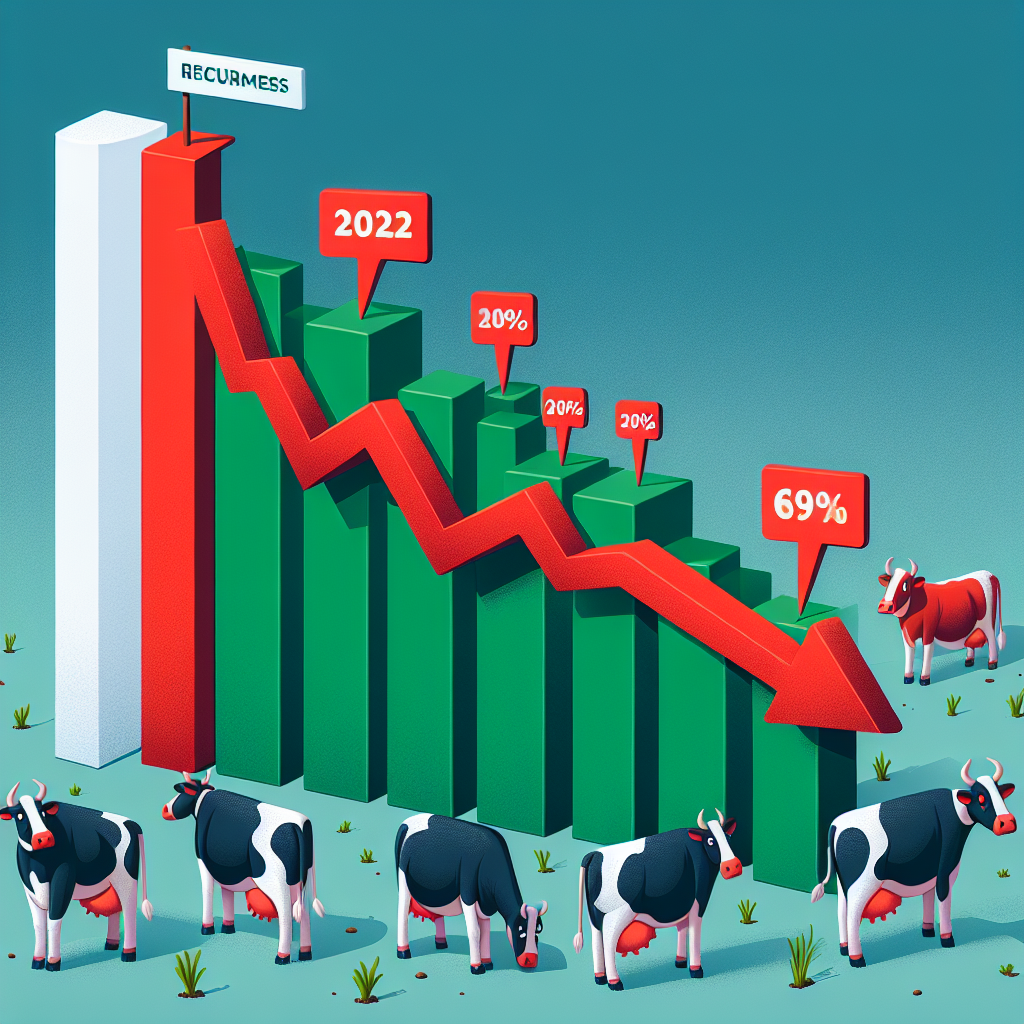Find out why 45% of South Ireland’s dairy farmers struggle with winter feed. Learn ways to secure your feed and manage stock better. Are you ready?
Summary:
As we approach the harsher months, a troubling report highlights that nearly 45% of dairy farmers in the south of Ireland find themselves without sufficient winter feed. According to the latest Teagasc fodder survey, this alarming statistic reflects a more significant national issue, with only 62% of farms having secured their winter feed supply, including a one-month reserve, and 18% facing shortfalls exceeding 10% of their feed requirements. Experts urge immediate action, recommending farmers increase their forage or reduce their livestock numbers to mitigate the risks. Aisling Claffey, a ruminant nutrition specialist with Teagasc, stresses, This shortage exposes the vulnerabilities within our agricultural system, urging farmers to rethink their strategies and prepare more effectively.
Regional differences in feed supply further emphasize the crisis, with only 55% of dairy farms in the south having enough feed compared to 74% in the northwest, highlighting the need for strategic planning and specialized measures.
Key Takeaways:
- Nearly 45% of dairy farmers in southern Ireland lack sufficient winter feed, highlighting a regional disparity.
- A national survey indicates that only 62% of farms nationwide have secured winter feed, including a one-month reserve.
- Farmers are encouraged to complete a fodder budget and take early action to address feed deficits.
- Feed stock improvements have been noted, but some farms face ongoing challenges with lower-than-target grass covers.
- Approximately 30% of farmers expect cash flow issues over the winter due to additional feed purchases.
- Regional disparities show the northwest with the highest feed levels, while the midlands northeast faces significant deficits.

Winter is approaching, and the cold weather might mean doom for almost half of the dairy producers in southern Ireland. According to the most recent Teagasc fodder study, 45% of these farmers do not have enough winter feed to keep their cows, indicating a growing issue with far-reaching consequences for the dairy sector. The poll collected data from over 650 farms throughout the country and found that just 62% of Irish farms had obtained the required winter feed, including a one-month reserve. In contrast, 18% had shortfalls exceeding 10% of their feed requirements. “We encourage all farmers to complete a fodder budget for their farm if they have not already done so; take early and appropriate action to secure fodder and reduce demand,” says Aisling Claffey, Teagasc’s ruminant nutrition expert. This poll is an important barometer for the dairy farming community, providing light on readiness levels and flagging areas needing work. Proactive actions are required to reduce the possibility of feed shortages, which, if not handled, might negatively influence animal health and farm profitability and should be a top priority for every farmer.
Winter Feed Crisis Looms for Southern Ireland’s Dairy Farmers
The 2024 Teagasc fodder study offers a thorough overview of the winter feed shortage affecting dairy producers in southern Ireland. The findings show a substantial deficiency, with just 55% of area dairy farms having enough feed reserves. This sharply contrasts the national average, where 62% of farms have successfully acquired winter feed, including a one-month reserve. Furthermore, 18% of farms have shortfalls surpassing 10% of their feed needs, raising worries about their viability during winter.
The 2024 Teagasc fodder survey results show an overall deficiency in winter feed and regional differences in feed supply. At the same time, the south area is severely strained, with just 55% of dairy farms having enough feed; dry stock producers in the northwest fare better, with 74% having enough feed supplies. This discrepancy emphasizes the need for specialized measures to alleviate feed shortages. In the midlands northeast, for example, just 55% of dairy farms have enough feed, putting them in a problematic situation as winter approaches.
These numbers underscore the critical need for strategic planning to address the food crisis. By analyzing their conditions and taking necessary actions, such as completing fodder budgets and acquiring more forage, dairy producers can mitigate the risks posed by these deficiencies. This strategic approach empowers them to face the cold months confidently and quickly.
Understanding the Root Causes of the Feed Shortage: A Perfect Storm
To comprehend the feed scarcity situation, it is critical to investigate the contextual factors contributing to this frightening condition. Weather patterns have had a significant impact. Unpredictable weather in recent years, ranging from arid summers to protracted rainy spells, has had a considerable influence on grass growth and, as a result, silage output. For example, the summer drought of 2022 left many fields scorched, severely lowering local fodder yields and forcing farmers to scramble to make up the difference as winter approached. This awareness of the underlying issues might help farmers make educated choices and take preventive remedies.
Economic factors increase the situation. The post-pandemic world has witnessed skyrocketing costs for crucial agricultural inputs such as fertilizers and gasoline, putting pressure on dairy producers’ narrow margins. Inflationary pressures on these inputs have made producing or buying feed more expensive. According to a Teagasc study, increased feed prices have pushed many farmers to reduce their purchases, exacerbating the shortfall.
Changes in agricultural policy also share some of the responsibility. Although good in the long run, recent legislative adjustments aimed at environmental sustainability have reduced methods that previously increased feed supply. For example, nitrogen use laws have reduced the inputs farmers may apply to their fields, reducing agricultural yields. Furthermore, the rules fueling the drive for organic farming are still in their early stages of efficacy and scalability, putting conventional feed production systems under pressure.
Weather inconsistencies, economic challenges, and changing agricultural regulations contribute to the present feed shortfall, creating a perfect storm that requires immediate and deliberate action.
Farmers Take Proactive Steps Amid Feed Shortage Fears
The survey data reveals that farmers are not passively waiting for the feed crisis to strike. About half of the respondents have taken proactive steps to secure more feed, demonstrating their unwavering commitment to their livestock’s well-being throughout the winter. This proactive approach showcases the farmers’ resilience and resourcefulness in the face of adversity.
Furthermore, 60% of farmers want to cut stock levels to minimize feed consumption. This intelligent decision allows them to match their available feed supplies with the nutritional requirements of their surviving animals.
Aisling Claffey, a Teagasc ruminant nutrition expert, underscores the importance of early action. “We encourage all farmers to complete a fodder budget for their farm if they have not already done so; take early and appropriate action to secure fodder and reduce demand,” Claffey advises. This proactive approach, which includes verifying silage quality and selecting the highest-quality silage for newly calved cows and young growing animals, ensures that farmers are well-prepared for the challenges ahead.
Farmers must use this knowledge wisely to manage feed scarcity efficiently. By getting more fodder and judiciously lowering inventory, they’re better positioned to weather the storm.
If you’re among the 45% of Dairy Farmers in Southern Ireland Facing a Winter Feed Shortage, Take Strategic Action Now.
Teagasc professionals have provided several advice on managing these problematic conditions adequately.
First and foremost, a detailed fodder budget must be completed. This is more than simply a spreadsheet exercise; it is a lifeline. Calculating your farm’s unique feed demands allows you to spot shortages early and avoid a possible disaster. Teagasc’s ruminant nutrition expert, Aisling Claffey, emphasizes, “We encourage all farmers to complete a fodder budget for their farm if they have not already done so; take early and appropriate action to secure fodder and reduce demand.”
Testing the quality of your hay should be the next step. Not all fodder is created equally. Better-quality silage must be offered to newly calved cows and young developing animals. At the same time, lower-grade fodder may be provided to dry cows. This customized strategy guarantees that your most essential cattle get the nourishment they need to be productive. She cautions, “It is important to test silage quality and prioritize the best-quality silage for freshly calved cows and young growing stock.”
Evaluate your existing feedstocks and possible acquisition possibilities to get practical suggestions. If you want to purchase more fodder, do it early. Prices and availability often deteriorate as the winter continues. Alternative forages and vitamins should also be examined to help extend current resources.
Teagasc’s head of consulting services, Tom Curran, provides valuable insight: “Farmers should be cautious of winter feed stockpiles in the coming weeks and months. If action is taken quickly, the choices for resolving shortages will be more affordable and numerous.
Also, check your stocking rates. Lowering stock levels may reduce future feed demand and help present supplies last longer. Finally, speak with a Teagasc adviser about tailoring these broad ideas to your farm’s requirements and circumstances.
Your quick efforts may minimize serious consequences later. You can get through this phase by budgeting, testing, and prioritizing while keeping your cattle healthy and productive.
Regional Disparities Highlight Stark Contrasts in Winter Feed Preparedness Across Ireland
When we look at geographical differences, we can observe that certain places are dealing with more severe feed shortages than others. The southern portion of Ireland is especially heavily struck, with just 55% of dairy farms having enough feed. Dry stock farms in this area perform marginally better, with 59% obtaining enough feed.
The situation in the Midlands Northeast is as worrying. Here, just 55% of dairy producers have enough winter feed. The rate for dry stock producers is even more frightening, with 10% experiencing substantial feed shortfalls.
On the plus side, dry stock producers in the northwest area are far better, with 74% reporting enough winter feed, while 64% of dairy farms in the southeast report sufficient feed availability.
These figures show a striking disparity in Ireland’s rural environment. While some areas are well-prepared for the winter season, others confront significant obstacles that need fast and deliberate action.
The Financial Domino Effect of Winter Feed Shortages
The present feed scarcity has significant financial ramifications. According to the poll, almost 30% of respondents expect cashflow challenges throughout winter due to the need to purchase more feed. The immediate financial pressure is just the tip of the iceberg. If these cashflow issues are not appropriately addressed, they might escalate into more serious economic concerns. Increasing feed costs may affect profitability and threaten farm sustainability. Early intervention is critical. Farmers may reduce some of these risks by adopting proactive actions such as creating a fodder budget and sourcing sufficient feed well ahead of time. Strategic planning and prompt action assist in managing short-term cash flow while also protecting the farm’s financial health in the long run.
The Bottom Line
Over half of southern Ireland’s dairy producers are experiencing significant winter feed shortages. While some have started to get extra fodder or reduce stockpiles, the need for fast and strategic action remains urgent. Regional inequalities demonstrate that not all locations are equally equipped, emphasizing the need for specific interventions. Financial restrictions owing to the need to purchase more feed exacerbate the urgency, affecting cash flow for many.
If you are one of the impacted farmers, act quickly. Completing a fodder budget for your farm and taking early steps to ensure enough winter feed may significantly affect you. Assess your feed quality, emphasize high-quality hay, and explore alternate solutions. The steps you take now are essential to surviving this difficult moment and preserving the viability of your activities.
Learn more:
- Ireland’s Dairy Farmers Battle Persistent Rain
- Low Confidence Freezes Irish Dairy Farmers’ Investments
- Irish Dairy Farmer Income Plummets by 69% in 2023
 Join the Revolution!
Join the Revolution!
Bullvine Daily is your essential e-zine for staying ahead in the dairy industry. With over 30,000 subscribers, we bring you the week’s top news, helping you manage tasks efficiently. Stay informed about milk production, tech adoption, and more, so you can concentrate on your dairy operations.







 Join the Revolution!
Join the Revolution!





